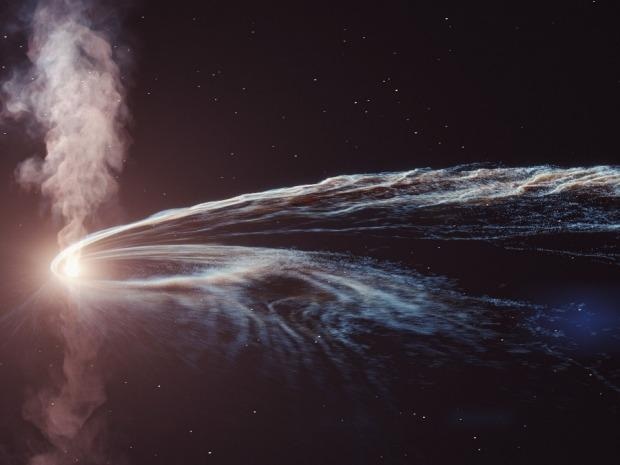Feb 23 2021
A research group has detected the existence of a high energy neutrino, a specifically elusive particle—as a result of the destruction of a star as it is gobbled by a black hole.
 After the supermassive black hole tore the star apart, roughly half of the star debris was flung back out into space, while the remainder formed a glowing accretion disk around the black hole. The system shone brightly across many wavelengths and is thought to have produced energetic, jet-like outflows perpendicular to the accretion disk. Image Credit: DESY, Science Communication Lab.
After the supermassive black hole tore the star apart, roughly half of the star debris was flung back out into space, while the remainder formed a glowing accretion disk around the black hole. The system shone brightly across many wavelengths and is thought to have produced energetic, jet-like outflows perpendicular to the accretion disk. Image Credit: DESY, Science Communication Lab.
Published in the Nature Astronomy journal, this breakthrough offers new insights into the origins of Ultrahigh Energy Cosmic Rays, which are particles with the highest energy in the Universe.
The study involved scientists from over two dozen institutions, such as New York University and Germany’s DESY research center, and dealt mainly with neutrinos—subatomic particles that can be generated on the Earth only in powerful accelerators.
Not just neutrinos but also the process by which they are made are difficult to detect, which makes their detection, together with that of Ultrahigh Energy Cosmic Rays (UHECRs), remarkable.
The origin of cosmic high-energy neutrinos is unknown, primarily because they are notoriously hard to pin down. This result would be only the second time high-energy neutrinos have been traced back to their source.
Sjoert van Velzen, Study Lead Author and Postdoctoral Fellow, Department of Physics, New York University
A video made by NASA, a research collaborator on the Nature Astronomy work, explains the study results in greater detail.
Swift Links Neutrino to Star-destroying Black Hole
As the star approaches the black hole, the enormous tidal forces stretch it more and more until it is finally shredded. Half of the stellar debris is flung back into space, while the remaining part forms a rotating accretion disk from which two strong outflows of matter shoot up and down. The system acts as a powerful natural particle accelerator. Video Credit: NASA’s Goddard Space Flight Center.
An earlier study carried out by van Velzen, who is now affiliated to Leiden University in the Netherlands, and NYU physicist Glennys Farrar, a co-author of the new Nature Astronomy paper, discovered some of the first proof of black holes ruining stars through the so-called Tidal Disruption Events (TDEs).
These results pave the way for finding whether TDEs could be behind the generation of UHECRs.
The study published in the Nature Astronomy journal supports this conclusion.
The IceCube Neutrino Observatory, a National Science Foundation-backed detector situated in the South Pole, previously announced the detection of a neutrino, the path of which was traced afterward by the Zwicky Transient Facility at Caltech’s Palomar Observatory.
Its measurements essentially indicated a spatial coincidence of a high-energy neutrino and light emitted following a TDE—a star gobbled by a black hole.
This suggests these star shredding events are powerful enough to accelerate high-energy particles.
Sjoert van Velzen, Study Lead Author and Postdoctoral Fellow, Department of Physics, New York University
“Discovering neutrinos associated with TDEs is a breakthrough in understanding the origin of the high-energy astrophysical neutrinos identified by the IceCube detector at the South Pole whose sources have so far been elusive. The neutrino-TDE coincidence also sheds light on a decades old problem: the origin of Ultrahigh Energy Cosmic Rays,” added Farrar, who suggested that UHECRs could be expedited in TDEs, in a paper published in 2009.
The study was financially supported by grants from the National Science Foundation (CAREER grant 1454816, AAG grant 1616566, PIRE Grant 1545949, NSF grant AST-1518052).
Journal Reference:
Stein, R., et al. (2021) A tidal disruption event coincident with a high-energy neutrino. Nature Astronomy. doi.org/10.1038/s41550-020-01295-8.